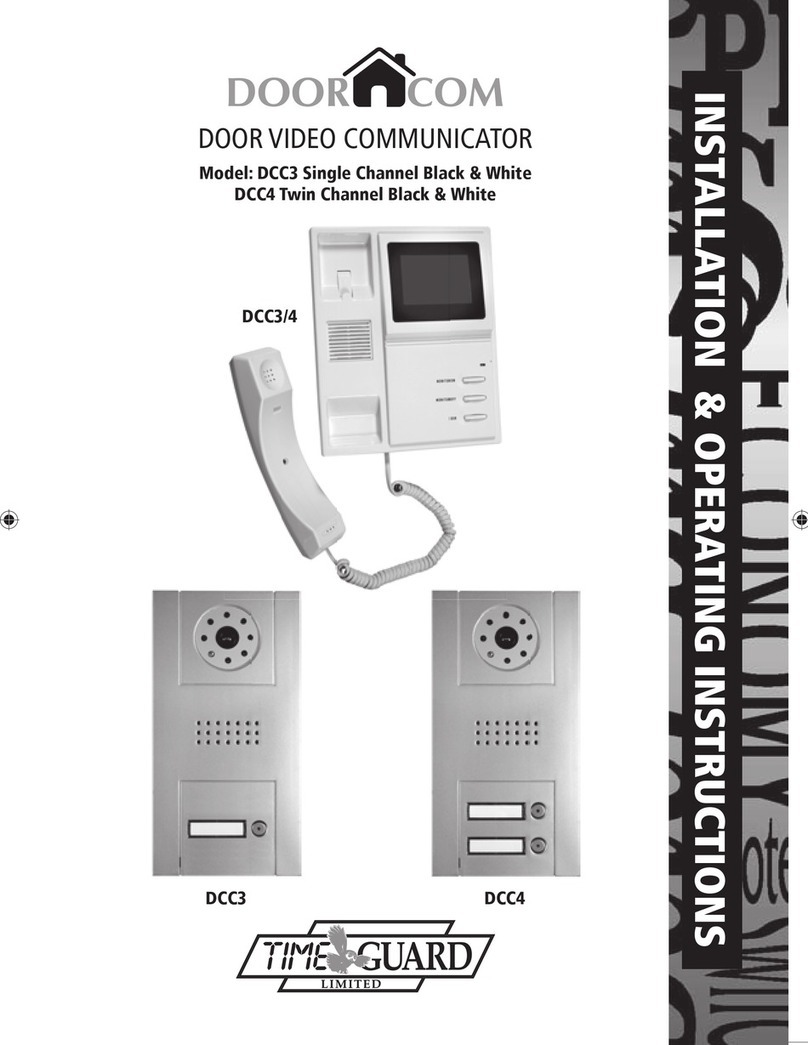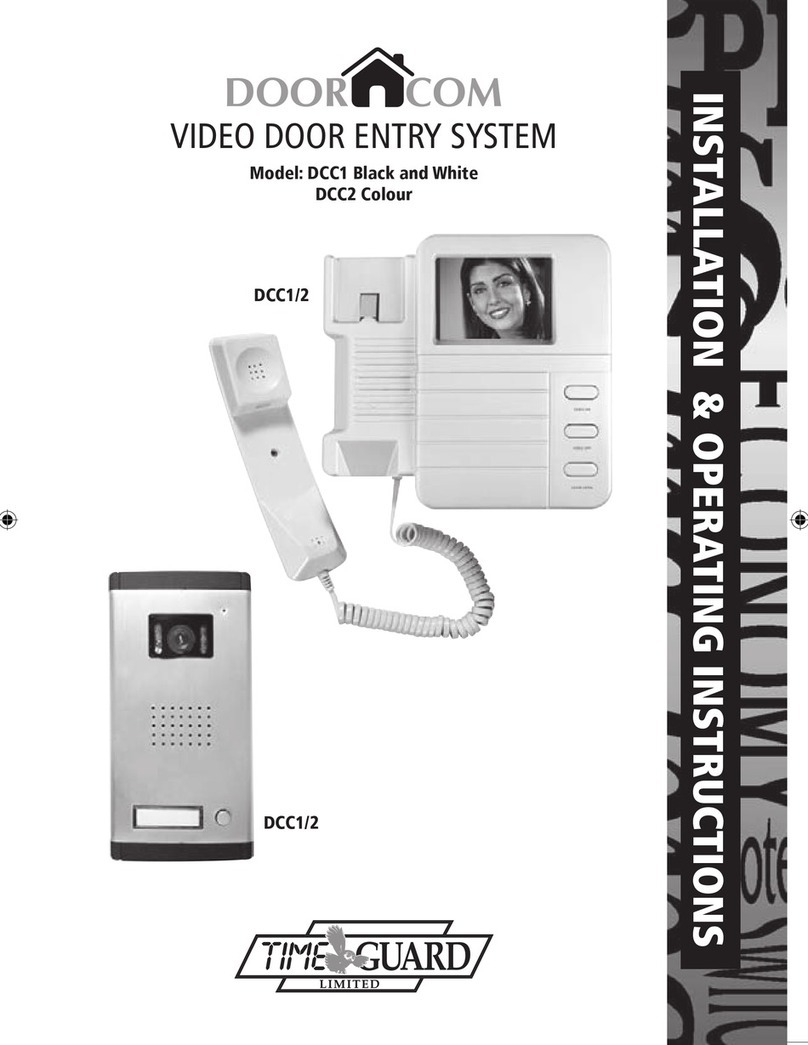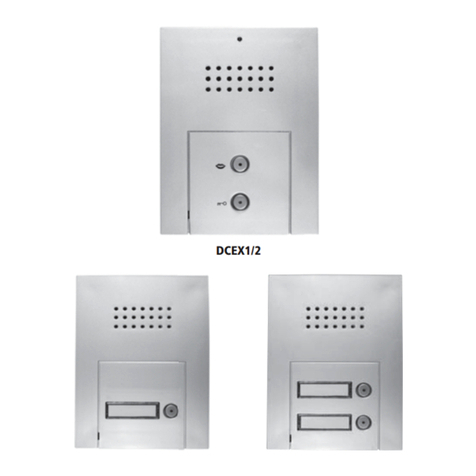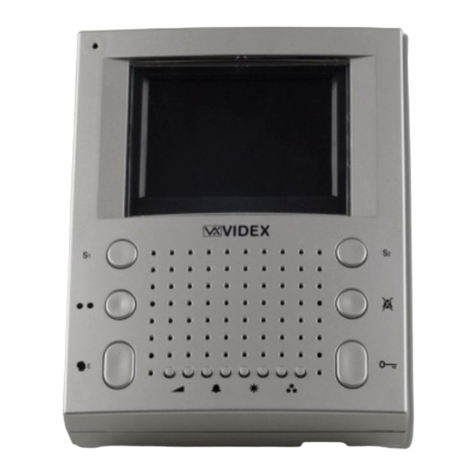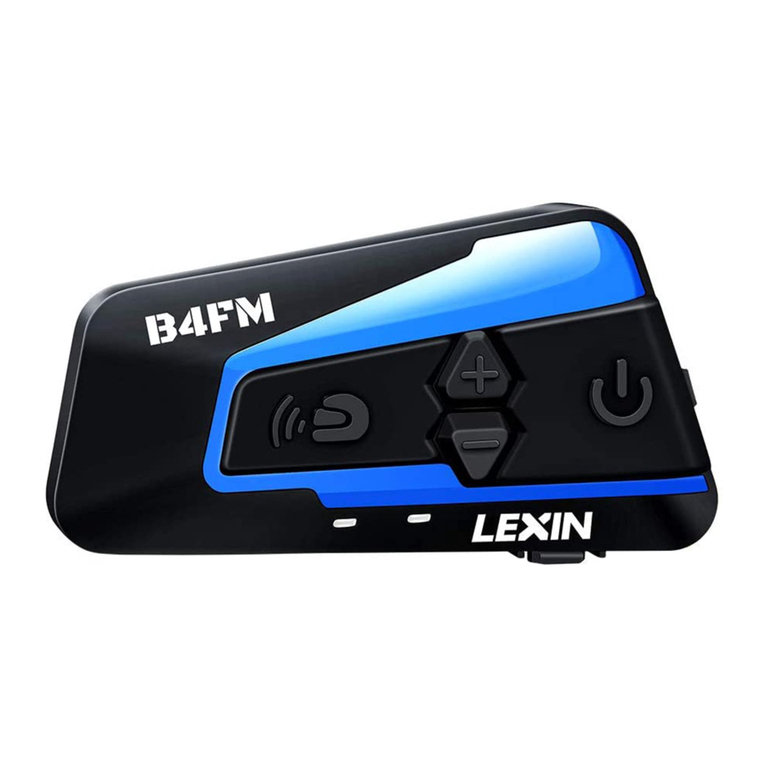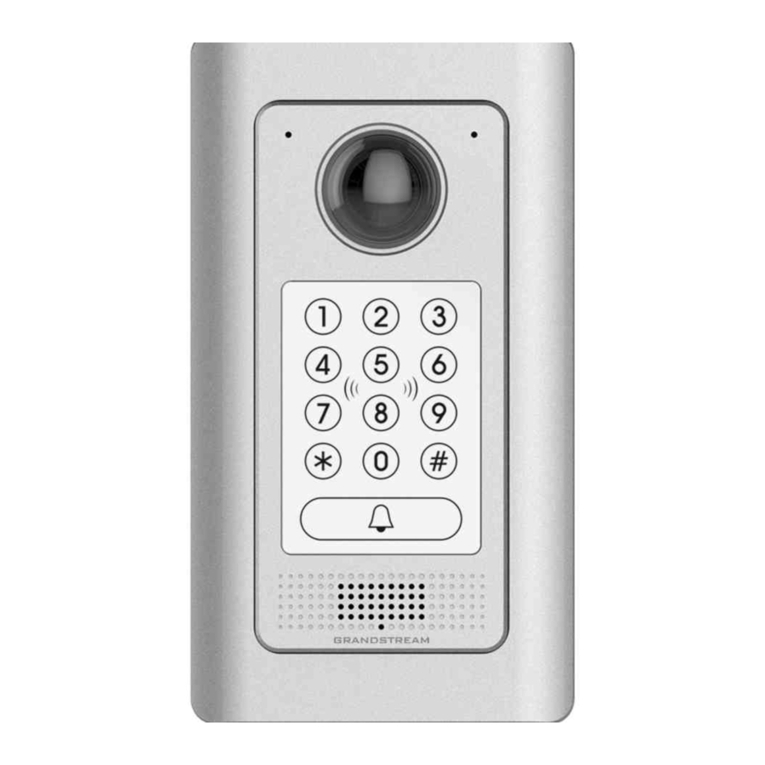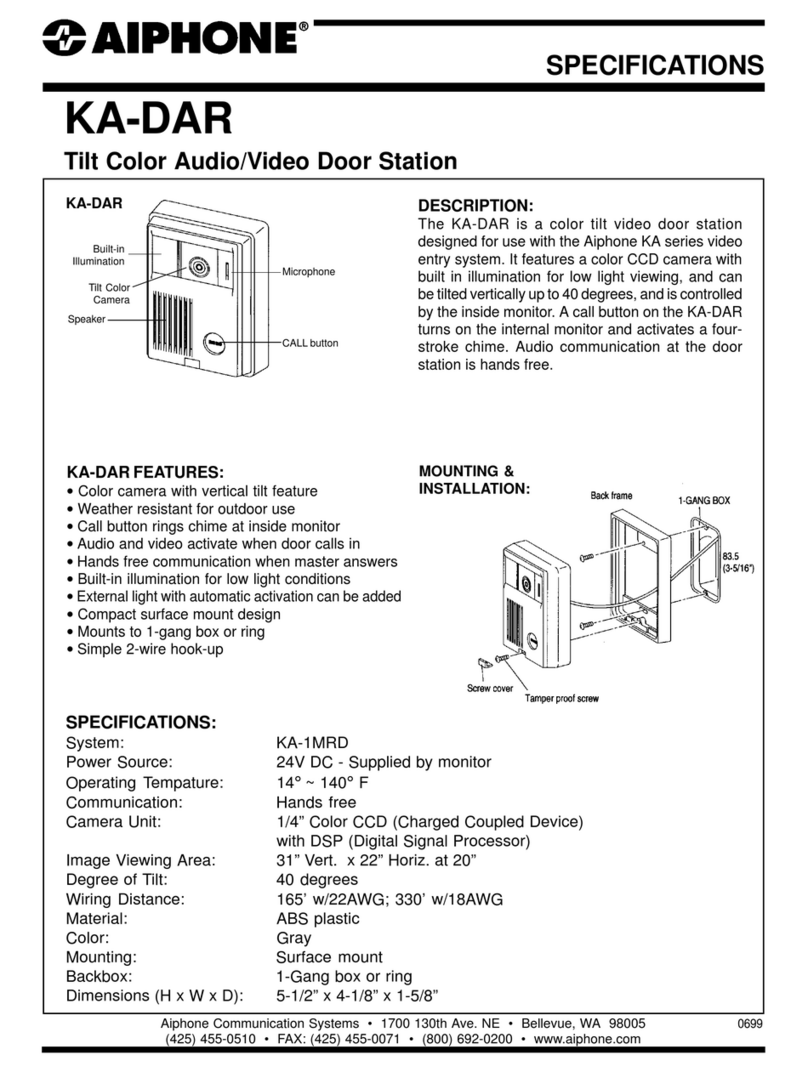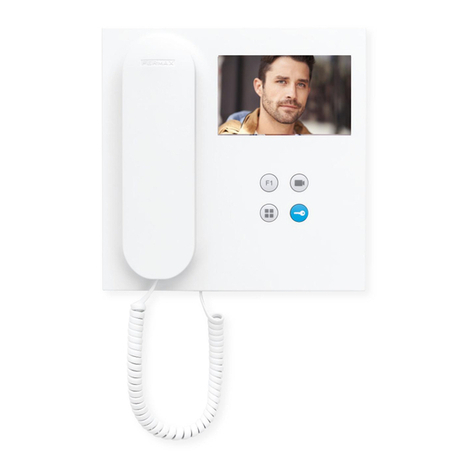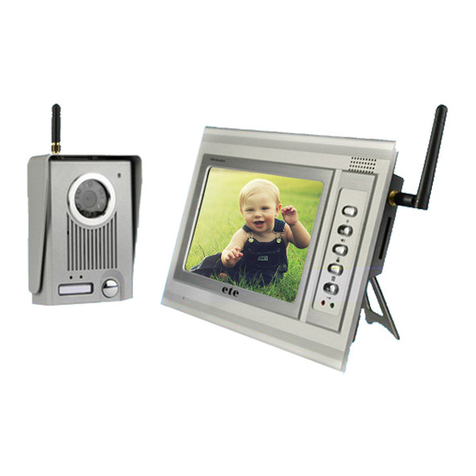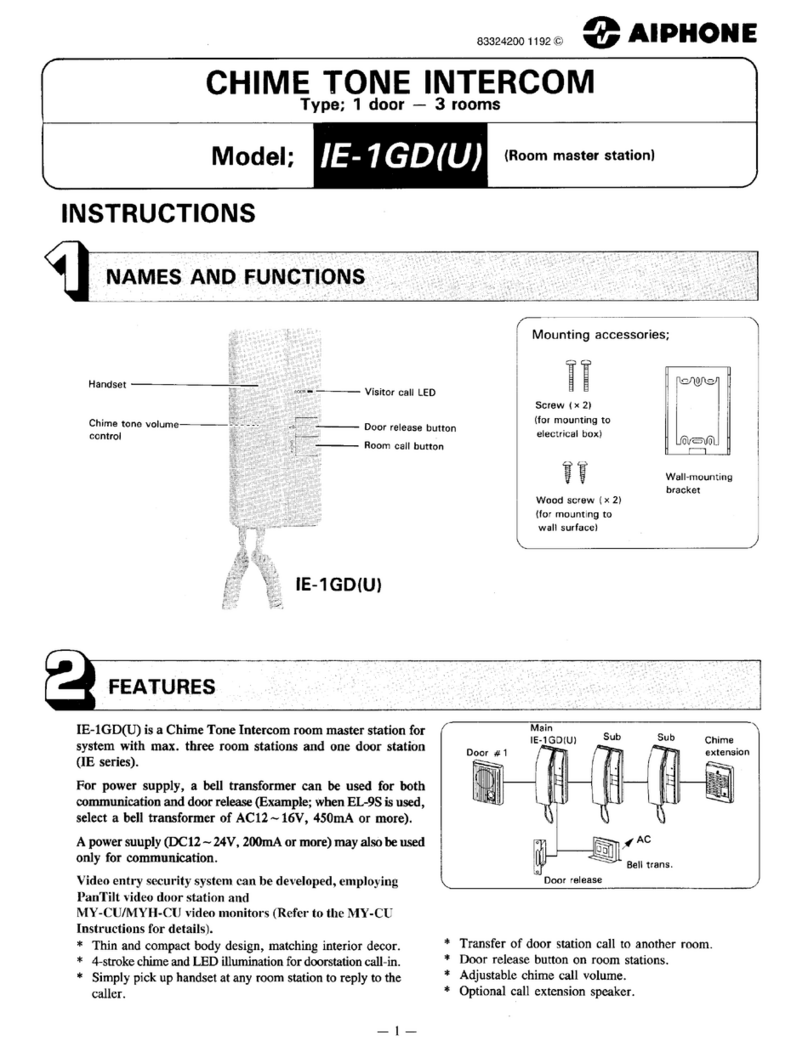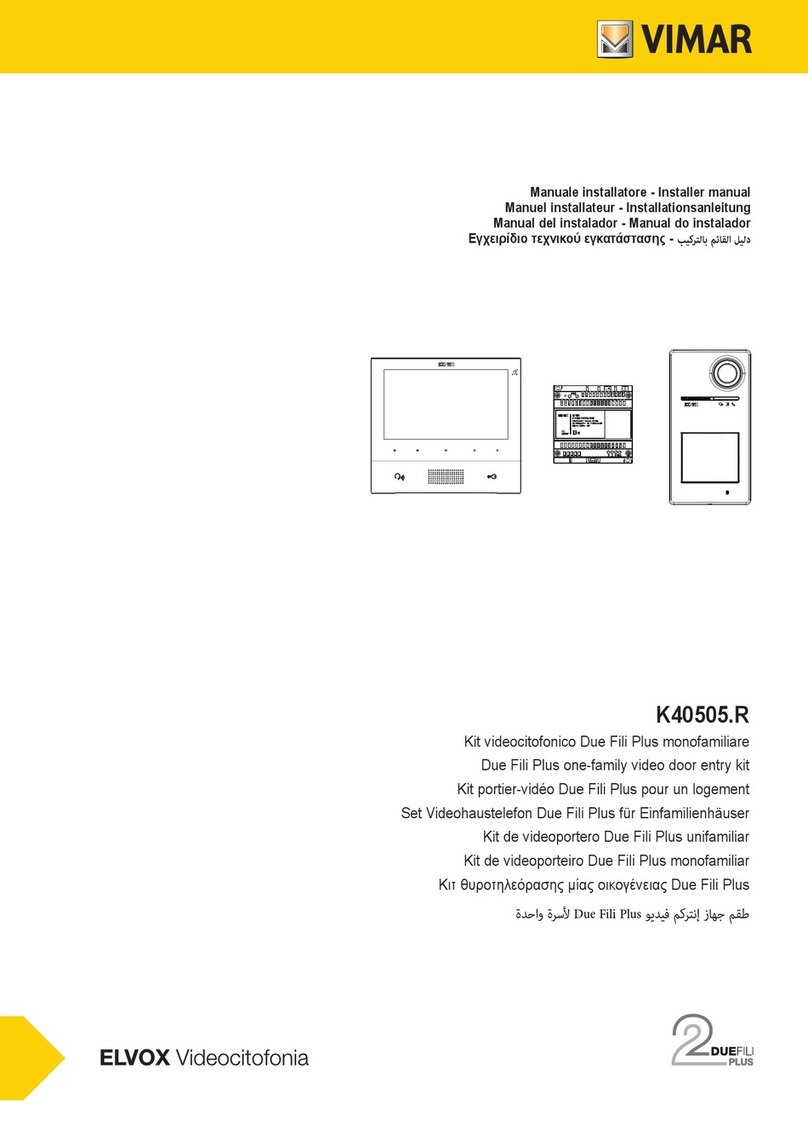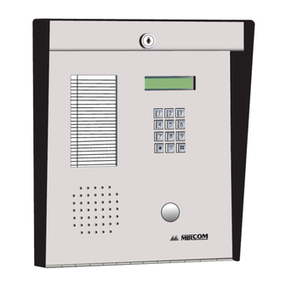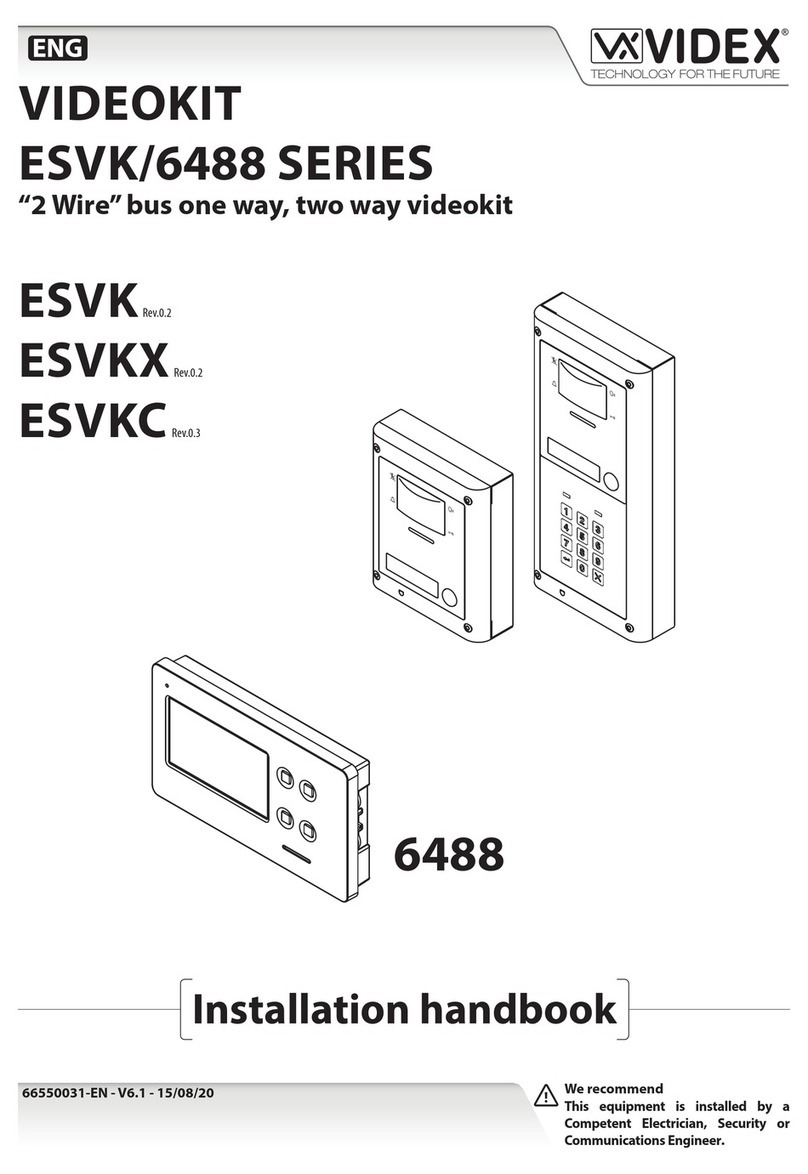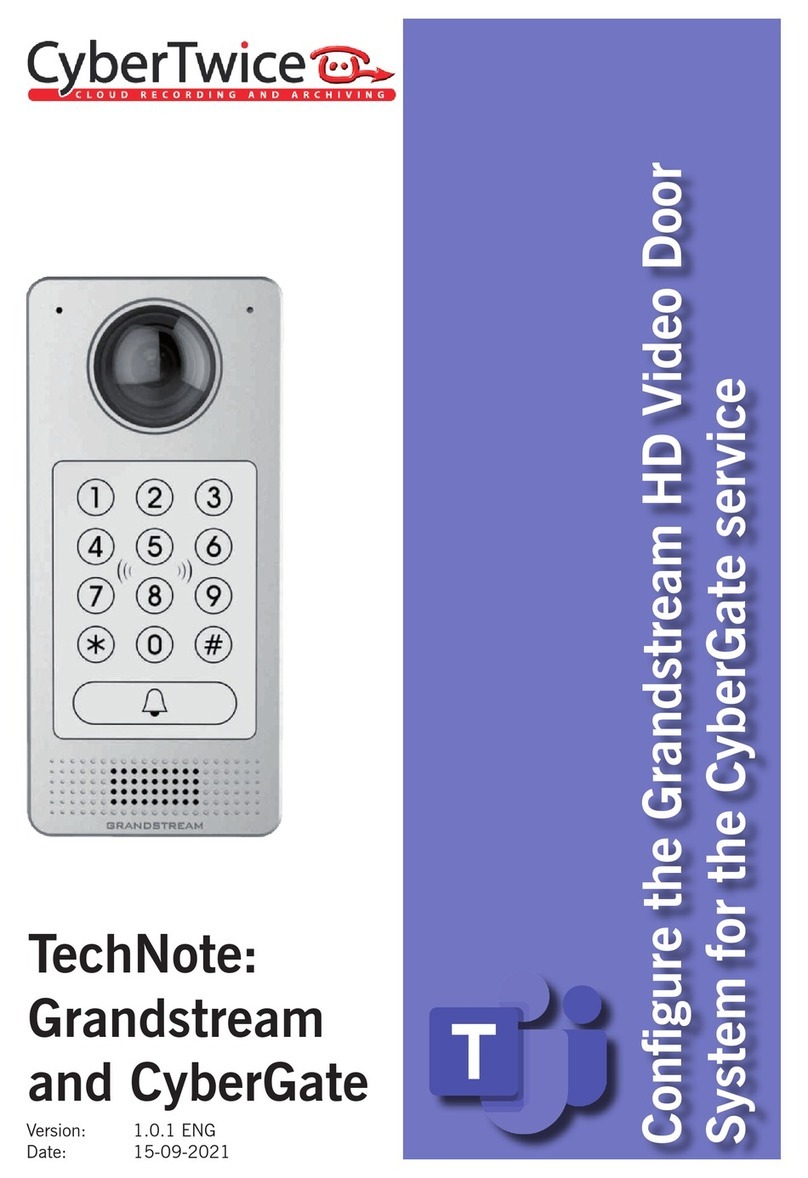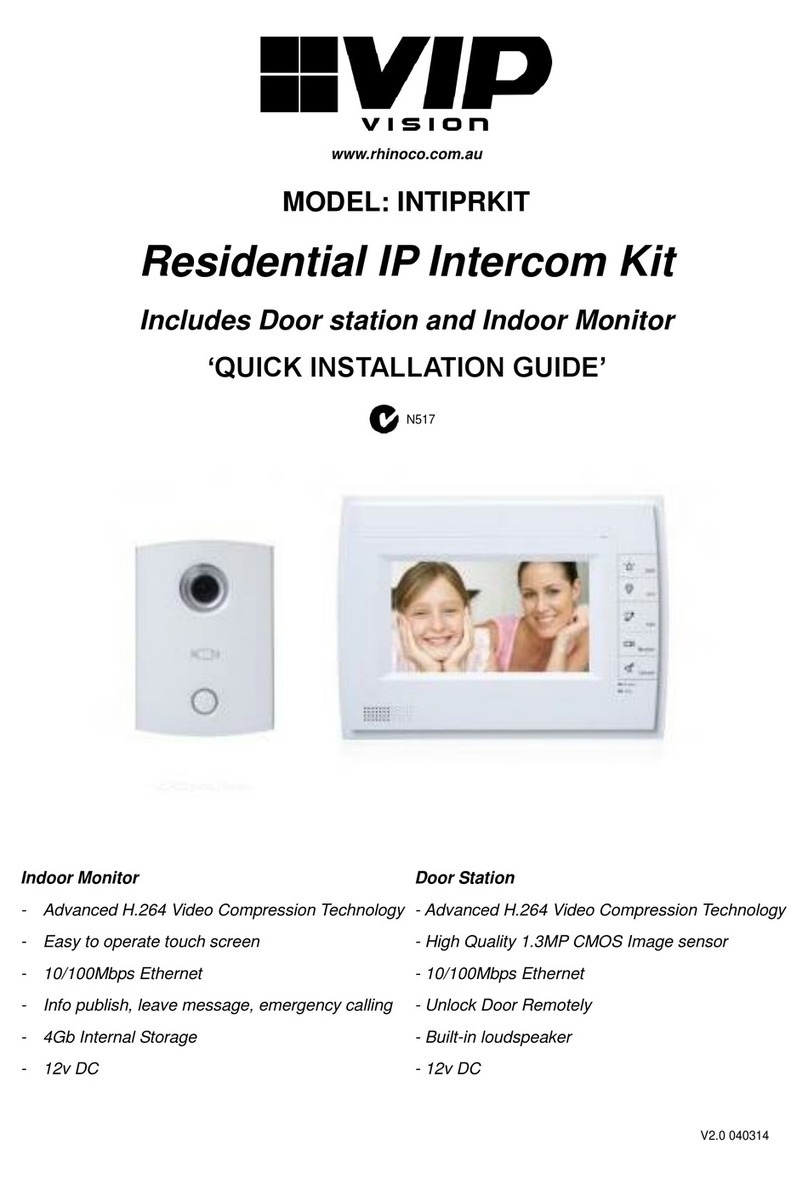Timeguard DoorCom DCEX3 Manual

INSTALLATION & OPERATING INSTRUCTIONS
AUDIO DOOR ENTRY SYSTEM
Model: DCEX3 Single Channel Colour
DCEX4 Twin Channel Colour
DCEX4DCEX3
DCEX3/4
DCEX3_DCEX4_Instructs_1.3.indd 1DCEX3_DCEX4_Instructs_1.3.indd 1 30/1/07 11:08:56 am30/1/07 11:08:56 am

1
17
16
19
10
15
14
1 2 3
HI
LO
NAME PLATE
NAME PLATE
1
4
6
3
2
5
12
20
13
1. Introduction
The DCEX3/DCEX4 Door Entry System enhances entry security by enabling
the user to recognise the visitor by audible and visual means before
opening the door.
An electric door catch (not supplied) is available as an optional extra for the
DCEX3/DCEX4 to make the door opening automatic.
The external and internal intercoms are connected by a two core cable. With
the cable supplied the distance between these units is limited to 15m. By using
13/0.2 bell cable this distance can be increased to a maximum of 70m.
2. Product Overview
If operation with an electric door catch is required then part DCLR is a fail
(power off) secure catch available from Timeguard. See fig 2 for wiring of this
part. An additional two core cable run (using 13/0.2 bell flex) will be required
between internal intercom and door catch.
1. External intercom.
2. Internal intercom.
3. Name plate.
4. Loudspeaker.
5. Power on indicator.
6. Ring button.
7. Keyhole fixing.
8. Screw terminals.
9. Slot for angle bracket (15).
10. RJ-11 plug.
11. Mains adaptor low voltage
socket.
12. Speak button.
13. Door open button.
14. Mains adaptor.
15. Angle bracket.
16. Volume switch (Hi/Lo).
17. Connecting cable.
18. RJ-45 socket.
19. Ring tone selector.
20. Quiet observation button.
Fig 1a - External Intercom
(front view) DCEX4 shown
Fig 1b - Internal Intercom
(front view)
Fig 1c - Internal Intercom (side view) and
remaining parts
DCEX3_DCEX4_Instructs_1.3.indd 2DCEX3_DCEX4_Instructs_1.3.indd 2 30/1/07 11:09:02 am30/1/07 11:09:02 am

2
8
11
18
Internal intercom
Fig 2 - Wiring diagram
DCEX3 (single channel)
External intercom
Door catch
DCEX4 (twin channel)
Door catch
Alternative low
voltage supply
connection
Alternative low
voltage supply
connection
DCEX3_DCEX4_Instructs_1.3.indd 3DCEX3_DCEX4_Instructs_1.3.indd 3 30/1/07 11:09:02 am30/1/07 11:09:02 am

3
30cm
165
cm
75º
165
cm
3. Selecting intercom sites and cabling
3.1 Intercom sites
The internal intercom should be located at a convenient position for all potential users
at the height indicated in fig 3a and at a maximum distance of 70m from the external
intercom. If all the users are significantly above or below average height then a different
mounting height may be considered appropriate.
The external intercom should be sited in an area away from driving rain
and surface water, out of direct sunlight as far as possible and protected by the
minimum of an open porch in a position readily accessible to potential entrants. It
should be mounted at the height indicated in fig 3b.
Fig 3a
Internal intercom
mounting height
Fig 3b
External intercom mounting
height and coverage
3.2 Cabling
Connection between the internal and external intercoms is by 2 core cable and must not
be more than 70m long. Two core (13 x 0.2) bell flex is suitable.
A 15m length of 2 core cable is supplied with the kit terminated at one end with an RJ-
11 plug which connects to the RJ-45 socket on the internal intercom. Existing bell cable
runs can be made use of.
The cable run should be kept at least 100mm away from mains cables to avoid
interference.
A second relatively short 2 core cable will be required between the external intercom
and the door catch (if used).
A further 2 core cable will be required to extend (if necessary) the cable between the
external intercom and the second internal intercom for the DCEX4.
DCEX3_DCEX4_Instructs_1.3.indd 4DCEX3_DCEX4_Instructs_1.3.indd 4 30/1/07 11:09:03 am30/1/07 11:09:03 am

4
7
9
15
External
intercom
4. Fixing Intercoms
4.1 External intercom
Important: To give the best possible waterproofing and appearance we
recommend taking the wiring through the exterior wall directly over the
wiring terminals of the intercom. If the surface to be fixed to is not even (e.g.
pebbledash or brickwork with raised pointing) we recommend the use of at least
10mm (3/8") thick marine ply as a mounting plate between the wall and the
intercom to give a flat surface for its 3 point fixing.
Use the template provided to mark the positions of the three fixing holes. Drill and, if
necessary, plug these holes for No. 8 roundhead screws.
Drive the top two No. 8 roundhead screws in leaving 3mm of the shank exposed (see fig 4).
Fig 4
Wall surface
3mm
The third screw is used to secure the angle bracket (15) to the wall (see fig 5).
Pass the cable(s) through the wall hole and terminate the cable from the internal intercom
ensuring that the brown and red wires are connected to the terminals of the same colour
on the external intercom (particularly important if an extension cable is used).
If a DCEX4 is being installed then a second cable will be required to connect to the
additional internal intercom maintaining polarity as before.
If a door catch is to be used connect an additional two core cable to the terminals on the
external intercom marked door opener (not polarity conscious).
Offer up the external intercom to the fixing points feeding the cable(s) back through the
wall as necessary. Locate the larger part of the keyhole fixings on the heads of the two
fixing screws (see fig 5) and, keeping the rear of the case clear of the angle bracket (15),
push the external intercom downwards to locate the screws on the narrower part of the
keyhole fixing.
Push the lower part of the external intercom towards the wall taking care
to locate the angle bracket (15) in the slot (9). Insert the screw supplied
through the countersunk hole in the lower edge of the external intercom and screw home.
If the fixing surface is uneven it may be necessary to increase the exposed shank of one or
both of the top fixing screws to get a satisfactory fit.
Fig 5
DCEX3_DCEX4_Instructs_1.3.indd 5DCEX3_DCEX4_Instructs_1.3.indd 5 30/1/07 11:09:03 am30/1/07 11:09:03 am

5
4.2 Internal intercom
Choose a position which can be reached easily by all potential users. If one person
usually in one location will be the main user it may be considered appropriate to locate
the internal intercom within reach of that person.
Use the template provided to mark the positions of the three fixing holes.
Drill and, if necessary, plug these holes for No 8 roundhead screws.
Drive the top two No. 8 roundhead screws in leaving 3mm of the shank
exposed (see fig 4).
The third screw is used to secure the angle bracket (15) to the wall (see fig 5).
Plug the low voltage cable from the mains adaptor into the socket on the reverse of the
internal intercom and feed the cable into the channel (20). Insert the RJ-11 (10) plug
on the connecting cable into the RJ-45 socket (18) on the lower edge of the internal
intercom.
Offer up the internal intercom to the fixing points.
Locate the larger part of the keyhole fixing on the heads of the two fixing screws (see
fig 5) and, keeping the rear of the case clear of the angle bracket (15), push the internal
intercom downwards to locate the screws on the narrower part of the keyhole fixing.
Push the lower part of the internal intercom towards the wall taking care to locate
the angle bracket (15) in the slot (9) and the connecting cable in the cable channel
(20). Insert the screw supplied through the countersunk hole in the lower edge of the
external intercom and screw home.
If the fixinng surface is uneven it may be necessary to increase the exposed shank of the
top fixing screws to get a satisfactory fit.
Finally tidy and clip the connecting cable and the mains adaptor low voltage cable as
appropriate.
4.3 Name Plates
Remove the transparent cover(s) using a small flat bladed screwdriver as shown in fig 6.
Lever out the plastic name plate(s) and mark as appropriate with a fibre tipped pen
marked permanent.
Protect case under blade with card or
folded paper.
Fig 6
1. Engage the screwdriver (flat) blade
in cover recess.
2. Push blade firmly into recess wall.
3. Maintaining pressure on recess lever
cover outwards against case.
DCEX3_DCEX4_Instructs_1.3.indd 6DCEX3_DCEX4_Instructs_1.3.indd 6 30/1/07 11:09:04 am30/1/07 11:09:04 am

6
5. Commissioning/Use
Press the ring button (6) at the external intercom – a buzz will be heard locally and at
the internal intercom the video monitor will power up and a ring tone will be heard for
two to three rings. Once the talk button is pressed two way communication is possible
via the microphone and speaker at each intercom. Finally, if a door catch is fitted,
the door open button (13) should be pressed and the door can be opened. It is not
necessary for the talk button to be pressed to use the door open facility. It is possible
to adjust the ringtone volume with the two position slide switch (16) on the side of the
internal intercom. Three choices of ring tone are available, use the switch (19) to select.
The video monitor can be powered up at any time by pressing the quiey observation
button. The audio system is suppressed during the one minute that the power up lasts.
6. Do’s and Dont’s
1. Never use the product if it shows any signs of damage.
2. In case of damage to the product unplug the mains adaptor from the mains supply
to avoid any possibility of electric shock and have the damage examined by a
competent person.
3. When laying cabling ensure that no cables (particularly mains cables) are damaged.
4. Never try to operate the mains adaptor at a voltage other than 230V 50Hz.
5. The installation should only be carried out by a competent person.
6. The internal intercom should be kept out of reach of children and unauthorised
persons.
7. Keep low voltage cabling at least 100mm away from any mains cabling.
8. Ensure that all electrical connections are made and wires are arranged according to
the instructions.
7. Troubleshooting
No Audio or Video Check cable between internal and external intercoms is
connected correctly.
Check that there are no breaks or damage to the
interconnecting two core cable.
Check that the mains adaptor is plugged in and
switched on.
Door catch not working Check cable between external intercom and door catch
for breaks or damage.
Check that terminations are correctly made at each
end of the above cable.
Check that the mains adaptor is plugged in and
switched on.
(if fitted)
DCEX3_DCEX4_Instructs_1.3.indd 7DCEX3_DCEX4_Instructs_1.3.indd 7 30/1/07 11:09:04 am30/1/07 11:09:04 am

7
For a product brochure please contact:
Timeguard Ltd.
Victory Park, 400 Edgware Road,
London NW2 6ND
020-8452-1112
HELPLINE
020-8450-0515
8. Cleaning
Unplug mains adaptor before cleaning product.
Clean internal and external intercoms with a damp cloth only – no cleaning agents.
Remove dust deposits from the louvres on the internal intercom with a soft brush or
vacuum cleaner.
9. Specifications
Mains adaptor: 230V 50Hz/15V, DC 1300mA
Maximum interconnect length between
internal and external intercoms: 70m (13/0.2 bell flex)
Power consuption Standby: 4W
In operation: 16W
Operating ambient temperature range: -10°C to +50°C (external intercom)
+35°C max (internal intercom &
mains adaptor)
Ringtone volume: 80dBA at 0.3m maximum
(adjustable by slide switch)
Door catch: Max 12V DC / 1A
3 Year Guarantee
In the unlikely event of this product becoming faulty due to defective material or
manufacture within 3 years of the date of purchase, please return it to your supplier in
the first year with proof of purchase and it will be replaced free of charge. For years 2
and 3 or any difficulty in the first year telephone the helpline on 020 8450 0515.
67-058-237
Recycling
When service life is over please consult your local
authority regarding method of disposal.
DCEX3_DCEX4_Instructs_1.3.indd 8DCEX3_DCEX4_Instructs_1.3.indd 8 30/1/07 11:09:04 am30/1/07 11:09:04 am
This manual suits for next models
1
Table of contents
Other Timeguard Intercom System manuals

